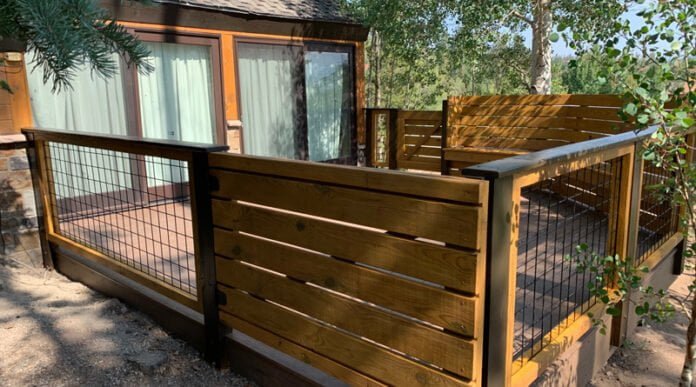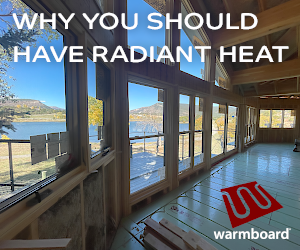Fewer new homes are being built with decks, according to the Census Bureau’s Characteristics of New Housing survey. The share of new homes built with a deck, or some combination of a deck, porch and patio, has fallen from 25% of new homes nationwide in 2010 to 21% in the most recent survey.
Homeowners are increasingly opting for a combined porch and patio, according to the survey, as those features increased from 24% of new homes built in 2010 to 33% in 2019.
“It wasn’t that long ago, and still in some markets you see this, where people were building decks at pretty much grade level,” according to Joe Raboine, director of Belgard Residential Hardscapes for Oldcastle APG Inc. As materials have evolved, and homeowners’ preferences and lifestyles have changed, outdoor living areas have gotten more sophisticated.
RELATED: Great, Wide, Open: Bringing the Great Outdoors to Homeowners’ Doorsteps
“People want things like outdoor fireplaces and fire pits, and a patio lends itself to that much better,” Raboine said.
He added that the conditions of a site will often determine whether a home has a deck or a patio. “In some markets, decks are inevitable,” he said.
High Country Colorado is just such a market. Trey Hudgins, owner of Rocky Mountain Decks in Silverthorne, said that with “the style of homes that are built here, you’d be hard pressed not to get a deck or patio with it. If you’re paying close to $1 million for a new home, or a lot more, then you know they’re definitely going to have a deck.”
While new homes in his area continue to be built with decks, Hudgins said that they have been getting smaller. He believes part of that has to do with new building codes adopted in Summit County that are increasing the price of homes by as much as 10%. While the updated codes don’t apply to outdoor structures like decks, the increase in price per square foot could lead some homeowners to downplay their outdoor living ambitions.
‘Contextually accurate’
Some homeowners may be tired of wood or composite decks that look like they were added to the home as an afterthought. Raboine is seeing more decks being designed that are “contextually accurate or cohesive with the home style.”
“We’re definitely seeing a transition where the deck is really looked at as a complete part of that outdoor space,” he noted. Modern decks might have masonry columns or integrate porcelain tile or pavers, he said.
“There’s much more of an architectural element to it than in years past, when you would just have 6-by-6 or 8-by-8 posts and it was all treated,” he said. “Now there’s much more going into these [decks] with mixed materials and components.”
For Hudgins, there are two types of customers.
“There are the investment homeowners who aren’t nearly as picky. They’re usually looking for more affordable options for their rental units,” he said. These owners might just want a functional space and be satisfied with a deck that will only last 15 years, but doesn’t cost as much up front.
Then there are customers who are looking for more of a luxury space.
“Those are the people who really get all the bells and whistles: lots of lighting, lots of the higher-end composite material, really nice railings, stainless steel cables, glass,” Hudgins said.
There’s been an increase in innovative products that allow builders and designers to do more for those clients, he noted. Plus, “as a builder, it’s a lot more fun when you have the opportunity to get creative.”
Maintenance-free deck materials
Higher-end products are especially important to Hudgins’ customers, he said, because the weather in Summit County can be harsh even by Colorado standards. Intense UV exposure, wild swings in temperature and dramatic freeze-thaw cycles leave their mark on homes at higher altitudes.
“Most homeowners [here], after a year or two of owning a home, are like, ‘What can I do that’s maintenance free?’” Hudgins said. He noted that even entry-level composite products can help extend the lifespan of customers’ decks. Some products come with warranties that last from 25 to 50 years, he said.
“By the time you get done putting in wood and stain—particularly last year because there was a shortage of materials—it was the same cost to do a wood deck as it was a composite,” he said.
Coloradans’ lifestyles can also beat up a deck. “You want to be able to walk barefoot in the summer on your deck,” Hudgins said, “and that’s really hard to do with wood, just because it does chip up here so fast, especially when you have things like shovels going over them, ski boots, you name it.”
Raboine noted that technology has evolved to make decking products even easier to take care of. Composites and railings are “much more maintenance-free than they ever have been,” and new products allow deck designers and contractors to offer their clients more interesting designs. Encapsulated composite decking is covered with a layer of plastic to make it more resistant to mold and “allows you to do really interesting things with texture and color,” Raboine said. MoistureShield offers decking products with CoolDeck technology that don’t get as hot in warmer temperatures.
“If people are worried about being barefoot, for instance, especially in warmer climates, it really reduces the amount of heat” coming off the deck, he said.
Contemporary decks
Hudgins said that his company’s projects have increasingly involved conversions from rustic decks with log rails to more contemporary styles. One thing he’s seeing a lot of is more intricate patterns in deck boards.
“Typically, decks have been always been done in 2-by-6 boards. What a lot of companies now are doing [is mixing] 8-inch boards, 6-inch boards and 4-inch boards, so that you can get a real interesting pattern with different colors,” he said. Hudgins’ team uses PVC board to accomplish the same thing for his customers.
“Now, you have a huge palette of colors and you can come up with some really neat designs. We usually do at least two colors on a deck … because we always picture-frame it; we put a border around the outside.”
Raboine is also seeing homeowners opt for more contemporary designs on their decks.
“There’s definitely a shift overall into more clean, linear contemporary styles, and I would blame the modern farmhouse for that,” he said. “It even crosses over into homes that are very traditional, so people just like that clean aesthetic.”
Minimalist railings, light colors and gray color palettes are key trends right now, he said. “It follows almost verbatim what’s going on in the hardscape section with pavers. People just want these two extremes: very light grays and whites, and dark, dark grays, and shying away a little bit from those earth tones,” he said.







